 Most viewed - JAPAN 日本 Most viewed - JAPAN 日本 |

Oiran courtesan. Also see my photos of an oiran show here. My oiran video at YouTube here.4430 viewsThe highest-ranking geisha is called an oiran or tayu. She is escorted by two little attendant girls called kamuro. Notice her high clogs. It takes some skill to walk in those and she usually requires someone's shoulder to hold onto while walking. Sometimes at festivals or special events, you can see the Oiran Dochu procession where she walks in a parade together with geisha attendants.
|
|

Oiran Dochu Procession, Tokyo Jidai Matsuri2525 views
|
|
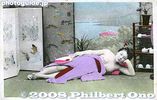
Nude woman lying down2234 views
|
|
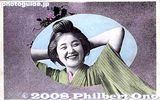
Out of all the geisha that have appeared on postcards, this ever-smiling geisha was unsurpassed in popularity. Her smiling visage appeared in 40 to 50 different poses in photographs and postcards made in Yokohama from the 1890s.2139 views
|
|

Sumo match with kids1975 viewsA retirement ceremony for an important sumo wrestler includes a variety of activities besides the actual ceremony of cutting away the topknot. It involves almost the entire Japan Sumo Association, and most wrestlers in the top three divisions (Makushita, Juryo, and Makunouchi) also appear in exhibition matches.
|
|
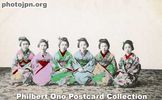
Brothel maids or prostitutes. Maids were employed to guide patrons to their rooms and serve sake and food. Or they could be low-class (cheap) prostitutes. Hand-colored, undivided back.1594 views
|
|

Snip by Yokozuna Asashoryu and a symbolic passing of the baton from one foreign yokozuna to the next (and only) foreign yokozuna.1527 viewsMongolia's Golden Age of Sumo has begun.
|
|

Kanamara Festival かなまら祭1400 viewsKawasaki, Kanagawa.
|
|

Yokozuna Musashimaru1341 viewsHis last dohyo-iri.
|
|

Musashimaru's final dohyo-iri1311 views
|
|
|

Asashoryu sips water offered by Ozeki Chiyotaikai1199 viewsAs soon as Asashoryu entered the arena, many wrestlers went up to him to offer water as a show of respect.
|
|

Kagurazaka Geisha1188 views
|
|

Koenji Awa Odori Dance 高円寺阿波おどり1148 viewsMore pictures here.
|
|

Asashoryu and Tochiazuma1131 viewsAfter offering water, Tochiazuma shares a laugh with the yokozuna.
|
|

Musashimaru right after I shook his hand.1074 views
|
|

Shin-Yoshiwara prostitutes. They are sitting behind the "cage" which fronted the street for all to see (and choose) within the licensed quarters. Shin-Yoshiwara was a famous red-light district of Tokyo. Note that they are not geisha.1059 viewsGeisha were not prostitutes. This photo was taken during 1907-1911. The woman in the far back was the brothel's matron who supervised this live display and everything else. In 1912 when Emperor Meiji died, this live display of women was later replaced by framed photographs of each woman hung near the brothel's entrance. In 1958, prostitution was outlawed in Japan, and Yoshiwara was history.
|
|

The final cut by stablemaster Musashigawa Oyakata.1024 views
|
|

Kumu hula Sonny Ching beats the ipu gourd drum, a traditional Hawaiian instrument. This must be a first, a kumu hula performing on the sumo ring in Japan.1010 views
|
|
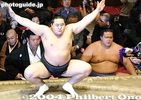
Final match of the day with Yokozuna Asashoryu993 views
|
|

Japanese Beauty. I would call this a representative example of a "Nihon Bijin" or Japanese Beauty photograph. She's posed formally, dressed in a kimono, and looking serene and attractive. She might bJe a geisha. Hand-colored, and undivided b987 viewsI bought it for 1,200 yen.
|
|

Flower arrangement. She's about to put the flower into the vase made of bamboo. On her lap, there's a pair of scissors used for flower arrangement. Her purple kimono has a design showing wisteria flowers. The season must have been spring.983 viewsThe card was printed in color so it's not that old.
|
|

Friends after all971 viewsKyokushuzan chats with fellow Mongolian Asashoryu.
|
|
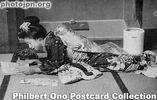
Maiko in Her Room912 viewsA private moment. This maiko is lying down in her kimono reading a comic book after getting tired of playing cards. Her mama-san probably would not be pleased to see her wrinkle the kimono like that. Not sure if this was staged or a candid shot. It's hard for anyone to lie down like that in a kimono.
|
|
|
|

Grand sumo tournaments are held six times a year in Jan., March, May, July, Sept., and Nov. They are held at Ryogoku Kokugikan arena in Tokyo in Jan., May, and Sept. In March, it is in Osaka, July in Nagoya, and Nov. in Fukuoka. This is the Kokugikan.900 views
|
|

Girl with Umbrella. Hand-colored postcard dating before 1918. The kimono looks like casual wear, and the design pattern was typical during the turn of the 20th century. She's still in her teens it seems. One of the first vintage postcards I bought. Y2897 views
|
|
|

Swimsuit Beauties. These are typical swimsuits worn during the late 19th century. Horizontal stripes were in vogue. They are not posed very well, but there's something charming about them. This postcard is postmarked Aug. 1912. A nice summertime greet885 views
|
|
|

847 viewsA retirement ceremony for an important sumo wrestler includes a variety of activities besides the actual ceremony of cutting away the topknot. It involves almost the entire Japan Sumo Association, and most wrestlers in the top three divisions (Makushita, Juryo, and Makunouchi) also appear in exhibition matches.
|
|

Takamisakari for butsuri keiko843 viewsEverybody cheered whenever he entered the ring.
|
|

The Kokugikan as seen from JR Ryogoku Station platform.842 views
|
|

Swimsuit pin-up. Another picture that makes you laugh. Apparently she felt sexy in that suit and knew how to pose like a pin-up swimsuit model.837 views
|
|

Musashigawa Stable wrestler wearing Aloha-print yukata835 viewsFlowery pattern (plumeria) with "Musashimaru" imprinted.
|
|

Musashimaru and his flowers826 viewsThis was his last appearance at this retirement ceremony.
|
|
|
|

818 views
|
|

Konishiki also sings. (His company arranged the entertainment.)807 views
|
|

"Robocop" Takamisakari gets ready803 viewsThe top-division Makunouchi wrestlers went through their matches quickly.
|
|
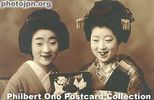
Geisha and maiko790 viewsNot a good photo, but their names are written in hiragana on the back. They read "Suimatsu" on the left and "Shigezuru" on the right who is a maiko, not geisha. She has more ornaments in her hair than the geisha. Also notice their blackened teeth. If they are in Kyoto, a geisha is called "geiko." In Tokyo, a maiko (apprentice geisha) is called "hangyoku." This is a postcard-size photo and not a postcard.
|
|

Laughing Geisha with umbrella. As you may have noticed, the umbrella (and fan) was a commonly used prop in tourist photos. Postmarked 1903 from Yokohama. The actual card is more yellowed and almost brown, but I bleached it with Photoshop.785 views
|
|

Former yokozuna Taiho, Takanosato, Kotozakura, and Wakanohana watch intently.741 views
|
|
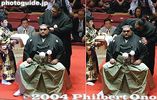
Snip and a hug by Konishiki (Question: Where was Akebono??)735 views
|
|

Beauty with fan. The white space around her was for writing the correspondence. You could not write the message on the same side as the address. The back of the postcard was for the address only.734 viewsSo it has an undivided back, which means there is no dividing line between the address side and correspondence side, Postcards with an undivided back were made between 1900 and March 28, 1907. That's how we know the approximate age of this card even though it has no postmark.
|
|

Commodore Perry Landing Monument. The Perry monument at Kurihama on the Miura Peninsula (Kanagawa Pref.) was built on July 14, 1901. It marks the spot where he first landed in Japan in 1853.704 viewsClick to see what the monument looks like today. I wonder what happened to it during the World War II. Was it destroyed or left untouched? This postcard was made to commemorate the visit of the US Fleet in Oct. 1908.
|
|
|

Ryogoku Kokugikan sumo arena as seen from Ryogoku Station682 views
|
|

He was grim-faced all throughout679 views
|
|

Matchlock gun demo at Azuchi Nobunaga Festival679 views
|
|

Tying the rope at the back.677 views
|
|

Musashimaru minus his topknot669 views
|
|

Rear view of the shiranui style of tying the rope.667 viewsHe turned in all four directions to show everyone what it looked like. This is what is called the shiranui style of tying the rope. It is characterized by a single loop in the back. The other style, called unryu, has twin loops.
|
|

Crazy sumo fan664 viewsThey also sold the real banzuke for 50 yen.
|
|

Box seats. Cramped space for four people.663 views
|
|

The bow twirler is a Makushita Division wrestler (third highest division). Afterward, the entire sumo ring is covered with a cloth. Also see my Kokugikan photos here.657 views
|
|

Hawaii's last sumo wrestler shakes hands.655 viewsIf he were married, his wife would be beside him.
|
|

Konishiki is called and he enters655 views
|
|

652 views
|
|

Snip by Musashimaru's brother646 views
|
|

Signboard for retirement ceremony at entrance.636 viewsIt reads "Musashimaru, Intai Danpatsu Hiroo Ozumo" which means "Musashimaru Topknot-Cutting and Retirement Sumo Exhibition."
|
|

Woman with pen and scroll. Judging from her hairstyle, this photo was probably taken during the Taisho Period (1912-1926).636 views
|
|

New Year's, Gifu Station634 views
|
|
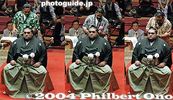
More blood relatives (or brothers)633 views
|
|

But his mom cannot step on the sumo ring...632 viewsFemales are prohibited from entering the sumo ring. Barring women from stepping onto the sumo ring, even to give an award to a wrestler, is one of the most blatant and preposterous forms of sexual discrimination in Japan. It was devised centuries ago, and for the sake of tradition, traditionalists in the sumo world have maintained this extremely absurd custom and belief that women are considered to be impure (due to menstruation). I'm not saying this as a gaijin (foreigner) who likes to criticize Japan or the Japanese. Nor am I saying this as a women's rights advocate. I say this from the standpoint of plain, old common sense.
Up to 1909, women were actually not allowed enter a sumo arena to view sumo matches. And once upon a time, women were prohibited from setting foot on sacred Mt. Fuji. Can you imagine if these traditions were still being practiced today?
Such discriminatory practices were abolished long ago, and here we are in the 21st century with women still unable to step into the sumo ring. The Japan Sumo Association has constantly rejected requests from important female ministers in the Prime Minister's Cabinet to give an award to the tournament winner in the sumo ring.
|
|

Snip by stablemate Ozeki Musoyama627 views
|
|

They wrap the rope around his waist from the front, or the thickest part of the rope.625 viewsThis was a demonstration on how they tie on the thick, white rope (tsuna) around his waist. The tsuna is the symbol of the yokozuna. It takes several assistants to put it on. They are all wearing white gloves.
|
|
|

Geisha Pair Outside Geisha House. These two geisha know how to pose for the camera. It looks like Kyoto. You can tell that they are geisha because of the shorter kimono sleeve, subdued kimono design (mostly black), and their clogs (for rainy weather).612 views
|
|
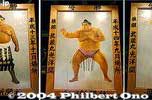
Giant painted pictures of Musashimaru decorating the arena inside. Each one commemorates a tournament victory.606 viewsThese giant pictures are actually black-and-white photographs taken in a photo studio and printed on large paper. Then it is hand-painted in color by a woman who has been doing it for years.
|
|

Nephews give a flower bouquet (they can step on the sumo ring)604 views
|
|

Bow twirling (called Yumitori-shiki) is the final ceremony at the end of the tournament day which is around 6 pm. 601 views
|
|

Me next please!!!596 viewsThe winner gets to decide who to wrestle next. The rikishi all beg to be picked.
|
|
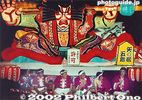
Nebuta Festival ねぶた祭595 viewsAomori
|
|
|

Oh, I gotta take a picture of this...594 viewsLook at the gyoji referee who must be thinking, "C'mon, hurry up!"
|
|

Comic sumo (shokkiri sumo)592 viewsThis is comedy time with two young wrestlers performing various comical antics (spitting at each other, kicking, and other illegal sumo acts) on the ring.
|
|

Maiko with umbrella. The quickest way to tell if she is a geisha or maiko is by looking at her back. The tell-tale sign of a maiko is her long obi sash hanging down behind. Whereas the geisha's sash has a short knot instead.592 views
|
|

Snip by Kitanoumi, the head of the Japan Sumo Association587 views
|
|

Musashimaru's final dohyo-iri585 views
|
|

584 views
|
|

Teruha with chrysanthemum. The flower she's holding matches her kimono design that shows the same flower. Her name was Teruha and she appeared in many postcards. She was born in 1896 in Osaka and worked as a geisha in Shimbashi, Tokyo. Click to read m584 viewsTeruha with chrysanthemum. The flower she's holding matches her kimono design that shows the same flower. Her name was Teruha and she appeared in many postcards. She was born in 1896 in Osaka and worked as a geisha in Shimbashi, Tokyo before becoming a Buddhist priest in Kyoto. Read more about her interesting life by James A. Gatlin at geikogallery.com.
|
|

Ozeki Musoyama is defeated.583 views
|
|

Musashimaru finally appears for a yokozuna belt demo582 views
|
|

Pulling it tight581 views
|
|

Musashimaru's final dohyo-iri579 viewsHe could have had Yokozuna Asashoryu be either the sword bearer or dew sweeper, but he chose to have his stablemates to join his final dohyo-iri.
|
|

His mom is next...577 views
|
|
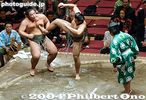
Comic sumo (shokkiri sumo)576 viewsThis is comedy time with two young wrestlers performing various comical antics (spitting at each other, kicking, and other illegal sumo acts) on the ring.
|
|

Musashimaru's final dohyo-iri568 views
|
|
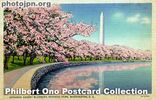
Cherry Blossoms, Potomac Park, Washington, DC。. Postcard made in the USA in the late 1930s or early 1940s. It was in 1912 (the year the Titanic sank) when Viscountess Chinda, the wife of Japan's Ambassador to the U.S., gave 2,000 small cherry trees.568 viewsIt was in 1912 (the year the Titanic sank) when Viscountess Chinda, the wife of Japan's Ambassador to the U.S., gave 2,000 small cherry trees to Mrs. Helen Taft, the wife of President Willian Taft. In a quiet ceremony, Mrs. Taft and Viscountess Chinda planted the first two cherry trees along the Tidal Basin in Potomac Park in Washington, DC. These two trees still exist today, marked by a special plaque. .
To read more about the interesting history of these cherry trees, see the National Park Service's Web site on the Washington Cherry Trees. You can read about how the original shipment of 2,000 cherry trees from Tokyo in 1910 had to be destroyed upon arrival in the US due to the infestation of harmful insects and diseases.
|
|

Sagami River Koi-nobori567 viewsMore pictures here
|
|

Kimono women going to a convenience store, Ako, Hyogo566 views
|
|
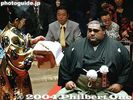
The scissors (golden)565 viewsI think it was given by French President Chirac who is a sumo fan.
|
|

Makushita sumo match564 viewsLower-division wrestlers wear black belts, while the upper division wrestlers wear white belts (during practice) or colored belts during official matches.
|
|

The End of Hawaii's Golden Age in sumo. For the first time since 1968, no wrestler from Hawaii is in the top Makunouchi division.564 views
|
|

Yumitori-shiki bow-twirling ceremony562 views
|
|
|
|

Musashimaru acknowledges a spectator as he proceeds to the ring.557 viewsThis was a demonstration on how they tie on the thick, white rope (tsuna) around his waist. The tsuna is the symbol of the yokozuna. It takes several assistants to put it on. They are all wearing white gloves.
|
|
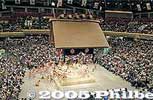
More people than the real tournament550 viewsAbout 8,000 people took time out from their Golden Week holidays to see this official sumo practice of all sumo stables.
|
|
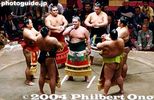
Sumo jinku545 viewsThey are singing sumo jinku, a chant-like song about sumo and sumo wrestlers. They are singing about Musashimaru and his career.
|
|

It is really good! Different flavors are offered during different days of the tournament. Top is shoyu (soy sauce) flavor, and bottom is salt flavor. Miso flavor is also offered.544 views
|
|

Practice539 views
|
|

This is the lower level with zabuton box seats costing over 10,000 yen.538 views
|
|

Asashoryu joins in537 views
|
|

Musashigawa stablemaster (former Yokozuna Mienoumi) in the entrance hall537 viewsInside the entrance hallway, there was a long table on the left side with ribbons which served as name tags for distinguished guests. Musashigawa is the name of Musashimaru's sumo stable.
|
|

Tres Flores. Intriguing pose. It looks like a modern postcard, but it's postmarked 1907!537 views
|
|
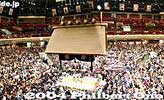
Panoramic shot of the Kokugikan532 viewsNotice the upper floor was quite empty, similar to Akebono's retirement ceremony.
|
|

Cigarette break on Coming-of-Age Day. Yes, they can now smoke legally.531 viewsAko, Hyogo Pref.
|
|

Woman on bicycle. That's a thick shawl she's wearing. Must've been winter. It's unusual to see a bicycle used as a studio prop. Riding a bicycle while wearing a kimono must have been difficult. The postmark looks like 1908. Hand-colored.529 views
|
|

Poor posture and how not to pose in a kimono.527 views
|
|

Musashimaru greets the crowd526 views
|
|
|
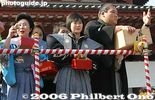
Nakamura Tamao (actress), Fukuhara Ai (tennis), and Tochiazuma at Zojoji Temple setsubun524 views
|
|

Snip by actor Hiroshi Fujioka, who played Kamen Rider in the '70s.522 views
|
|
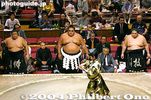
He performs his last yokozuna dohyo-iri ring-entering ceremony. He is flanked by Musoyama on the left as the sword bearer, and Miyabiyama on the right as the dew sweeper.521 views
|
|

Musashimaru's final dohyo-iri ends521 views
|
|

In front of mirror. Hand-colored postcard sent as a Christmas card in 1914.516 views
|
|
|
|

Yokozuna "tsuna" belt demo511 views
|
|

Awaiting the final cut as we listen to one of his famous matches.510 views
|
|

Exiting the building510 views
|
|

The Bulgarian (Kotooshu) on the left509 views
|
|

The thrown cushions are hastily piled up at ringside.508 views
|
|

507 views
|
|

Hairdressing demonstration506 views
|
|
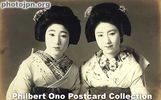
Pair of Geisha, autographed. One of my most treasured cards. This card was signed (on the chest area) by these two geisha with a fountain pen. Several other geisha also signed the back of the card. (See the next image.)506 views
|
|

505 views
|
|
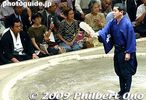
The yobidashi changes once in a while. Dressed in black and sitting as one of the judges is former yokozuna Chiyonofuji, now Kokonoe oyakata.505 views
|
|

503 views
|
|
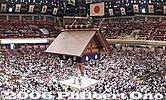
Panorama shot of sumo arena during a sumo tournament. There are two levels.502 views
|
|

499 views
|
|

Laughing Geisha with low neck. She's almost semi-nude. It is probably her sexiest pose of all. A great summertime card and one of my favorites. Hand-colored and postmarked Feb. 25, 1908 in Yokohama. The actual card is more yellowed.498 views
|
|

Typical woman and flower. Give a woman a flower and ask her to pose with it, and this is how she typically would hold it.498 views
|
|

Himeji Castle (National Treasure)496 views
|
|

Coming-of-Age Day, Himeji494 views
|
|

The kids gradually get bigger.490 views
|
|

Musashimaru doll489 views
|
|

Male hula dancer at one corner489 viewsThe original plan was for the hula dancers to perform on the ring itself. But at the last minute, Musashimaru decided that it was not appropriate so they danced outside the ring.
|
|

Snip by singer Shigeru Matsuzaki488 viewsFamous for his classic hit, "Ai no Memory."
|
|

Drawing of Commodore Perry, Grossly distorted if not humorous rendition of Commodore Perry by a Japanese artist who apparently never knew what Perry really looked like. It was drawn at a time when the Japanese thought all foreigners were barbarians.487 views
|
|

Two Patriotic Maiko. To cheer up the soldiers on the front line, pretty and smiling maiko (apprentice geisha) often appeared on postcards for military mail. This card was postmarked Aug. 1940 from Shizuoka city. It was not addressed to a soldier though.486 viewsBoth women are maiko and not full-fledged geisha yet. The sleeves of a maiko's kimono reaches toward the ground as you can see here. (The sleeves of a geisha is shorter.) The kimono design is also more colorful and gaudy. Maiko also wear clogs called pokkuri. They are wedged at the front, so if you are not careful, you can trip forward. Geisha do not wear pokkuri.
|
|
|

Both ozeki watch480 views
|
|

Musashimaru goes back and then comes back...479 views
|
|

Upper level and VIP booth.478 views
|
|

Girl in Storm. Wires were used inside the kimono to make it look wind-blown like in a rainstorm. Even her clogs are for rain. Early photographers commonly imitated the poses and scenes depicted in ukiyoe woodcut prints and Nihonga paintings.478 viewsAlthough the photographer and model were serious in making this picture, it makes you laugh.
|
|

Asashoryu in the face-off476 views
|
|

Butsuri keiko474 views
|
|

Upper level and giant sumo portraits of 32 past tournament winners. As of Jan. 2012, there are no portraits of Japanese sumo wrestlers. Only foreigners.473 views
|
|

Sapporo Snow Festival, Hokkaido473 viewsEarly Feb.
More pictures here.
|
|

Smiling for the camera. It's always nice to see a smiling woman on a vintage postard. This is not an ideal smile though. Kind of sheepish and unnatural. Sort of half-hearted and "halfway" like her fan which is only half open.473 views
|
|

Head supporter speaks472 views
|
|

Makunouchi dohyo-iri472 viewsNext was exhibition sumo matches by the top-division Makunouchi wrestlers. Musashimaru never appeared again.
|
|

Makunouchi dohyo-iri470 views
|
|

Giant portrait of Yokozuna Akebono469 viewsThese are B/W photographs painted over with oil.
|
|

Asashoryu later won468 views
|
|
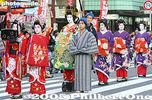
Tokyo Jidai Matsuri, Nov. 3466 viewsMore pictures here
|
|
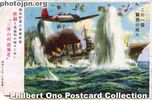
Wartime Mitsui Life Insurance ad card. Dated Feb. 1942, this advertising postcard shows a Japanese torpedo bomber dropping a torpedo aimed at a US battleship under heavy attack. An American flag (faint) can be seen on the ship's mast.466 viewsDated Feb. 1942, this advertising postcard shows a Japanese torpedo bomber dropping a torpedo aimed at a US battleship under heavy attack. An American flag (faint) can be seen on the ship's mast. The advertising copy reads, "This one shot is a phenomenal force." On the left, the text reads, "A new weapon for national savings." "Very low insurance premiums." "Mitsui's provision for old age" "It has no enemies!" For some reason, the left corners of the card were cut with scissors, perhaps to remove it from an album.
Needless to say, the lowest point in US-Japan relations was World War II. The Pearl Harbor attack, the internment of Japanese-Americans, battles at Midway and other Pacific islands, Tokyo fire bombing raids, land battle on Okinawa, and the nuclear bombing of Hiroshima and Nagasaki still reverberate among the generations today. Every year in August in Japan, ceremonies are held to mark and memorialize the Hiroshima and Nagasaki bombings and the war's end. All the while, Dec. 8 (7 in Hawaii) is just another day in Japan with no particular significance.
Of course in Hawaii, Dec. 7 is a day of national mourning as much as Hiroshima/Nagasaki Day in Japan. Each country mourns its own and neither seems to care about the other's war dead. I await the day when both countries mourn for each other as well as for themselves. After all, we all belong to the same family, the Family of Man.
|
|

Calling Musashimaru (with a conch shell)465 views
|
|
|
|

Mona Lisa Smile. She's cute, ideal for a passport photo. But her hairstyle is more striking than anything. What do you call it? A Westernized Japanese hairstyle?465 views
|
|

The retirement ceremony had a lot of Hawaiian touches. This was only the beginning.462 viewsHula dancers and live Hawaiian band from Hawaii.
|
|

Yokozuna Asashoryu performs his dohyo-iri ring-entering ceremony460 views
|
|

Sumo ring and suspended roof (no pillars).460 views
|
|

Laughing Geisha with Basket. It looks like she's dressed for picking tea leaves. This card, which has an undivided back, dates before 1907. The actual card is more yellowed.459 views
|
|

Maiko on Gojobashi Bridge. Postcard-size real photo taken in Kyoto. She has been poorly posed. Her posture is bad, her kimono is ruffled, the sleeves look bad, and her feet are pointing in the wrong direction. Maiko usually know how to pose themselves.458 viewsPostcard-size real photo taken in Kyoto. She has been poorly posed. Her posture is bad, her kimono is ruffled, the sleeves look bad, and her feet are pointing in the wrong direction. Maiko usually know how to pose themselves for a photograph. But not this one. Perhaps she's an amateur.
|
|

This must be a first, a kumu hula (hula teacher) from Hawaii performing on the sumo ring.455 viewsHe is Sonny Ching, a well-known hula teacher in Hawaii. He brought four male hula dancers who danced at the four corners of the ring.
|
|

Smiling Maiko Sitting. Real-photo postcard to cheer up soldiers. This card was sent as military mail from Kyoto on New Year's Day 1939. The kanji characters on the fan says "Banzai," the traditional Japanese cheer for victory and happy occas454 viewsReal-photo postcard to cheer up soldiers. This card was sent as military mail from Kyoto on New Year's Day 1939. The kanji characters on the fan says "Banzai," the traditional Japanese cheer for victory and happy occasions. It also means "long life," something that soldiers would like.
|
|

The chair451 views
|
|

In the entrance hall, hula and Hawaiian music direct from Hawaii449 views
|
|
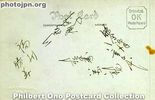
Pair of Geisha, autographed (back). This is the back of the preceding card. It looks like four geisha signed it.448 views
|
|

Here he comes...447 views
|
|

Takamisakari wins447 views
|
|

He goes back to the dressing room445 views
|
|

Woman with two flowers. She's holding the flowers in a cross or "X" mark. I wouldn't call that a good way to hold flowers (unless you're a hula dancer).445 views
|
|

Smiling Maiko Standing. Great smile. This is the same woman in the card where two maiko are holding the Japanese flag.441 views
|
|

Naosuke Ii and Commodore Perry. Issued in 1909, this postcard commemorates the 50th anniversary of the opening of Yokohama Port. It has a commemorative postmark marking the "Jubilee of Opening of Yokohama Port."440 viewsYokohama Port was officially opened to foreign trade on July 1, 1859 in accordance with the US-Japan Treaty of Amity and Commerce.
The card honors Naosuke Ii and Commodore Matthew C. Perry. You could say that Japan-America relations started with these two men. Ii was the Tokugawa shogunate's Great Elder (Tairo) who favored and concluded commercial treaties with the Western powers and thus broke Japan's isolation from the world. Foreigners were then allowed to trade with Japan and take up residence in cities like Yokohama and Hakodate. Ii was later assassinated in 1860 by people who sought to oust the foreign "barbarians."
Commodore Perry first came to Japan in July 1853 with his four warships which the Japanese called "black ships" (kurobune). No diplomatic breakthrough was made, but Perry's knocking on Japan's door was heard loud and clear. Running low on provisions, Perry departed for China and promised to return to Japan which he did in Feb. 1854. This time he got what he wanted. The Treaty of Kanagawa was signed about a month later. The treaty allowed US ships to call on two ports: Shimoda (Kanagawa) and Hakodate (Hokkaido). Permission for a US Consul (Townsend Harris) to reside in Japan was also stipulated. Official diplomatic relations between Japan and America thus began.
|
|

Sumo scoreboard. The names of all the wrestlers are displayed in the order of the sumo matches (from right to left). The winner is indicated with a red lamp. Names of sumo wrestlers absent from the tournament (due to injury, etc.) are listed on the far le437 views
|
|

Baby Baby Sitter. Such scenes were common in those days. Mom and dad were both busy farming, leaving the baby in the hands of older children. Hand-colored.436 views
|
|

Oil-painted card of Mt. Fuji. This is my favorite oil-painted postcard in my collection. The artist painted a few other cards like it. The artist's name was not signed, unfortunately. But the painting style is distinct.436 viewsI can't define what fine art is, but I know it when I see it.
|
|

Patriotic Maiko. Card designed to encourage soldiers on the front line. Notice that her sleeves are so long that you can see her right sleeve touch the ground. That's the kimono of a maiko. This is a modern postcard reproduction.435 views
|
|

Laughing Geisha with umbrella. The sender probably wrote about his incredible adventures in Japan. Postmarked 1904 from Yokohama addressed to Hamburg, Germany. The actual card is more yellowed and almost brown, but I bleached it with Photoshop.433 views
|
|

Asashoryu collects a big paycheck.433 views
|
|

Juryo sumo match430 views
|
|
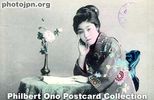
Flower in Vase. Nicely composed photograph. With a serene-looking face, she's an ideal postcard model. She also appears in the next postcard.430 views
|
|

Asashoryu gets thrown428 views
|
|

Juryo Division dohyo-iri ring-entering ceremony428 views
|
|

426 views
|
|
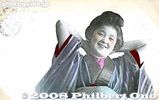
A saucy little Geisha. The pose is good.426 views
|
|
|

Teruha sitting.425 viewsHer name was Teruha and she appeared in many postcards. She's probably still in her teens in this photo. She was born in 1896 in Osaka and worked as a geisha in Shimbashi, Tokyo before becoming a Buddhist priest in Kyoto. Read more about her interesting life by James A. Gatlin at geikogallery.com.
|
|

Giant portrait of Yokozuna Takanohana424 views
|
|

A "darn it" look on his face423 views
|
|

Ready to pounce on the winner422 views
|
|

Cheek-to-Cheek. One of my favorite postcards. I wonder if they were sisters. Real-photo postcard with no divided back. The actual card is more yellowed, but I bleached it with Photoshop.422 views
|
|

After a bath. That's what it looks like. She was another very photogenic woman.421 views
|
|

Sumo exhibition matches with lower division Makushita wrestlers.420 viewsA retirement ceremony for an important sumo wrestler includes a variety of activities besides the actual ceremony of cutting away the topknot. It involves almost the entire Japan Sumo Association, and most wrestlers in the top three divisions (Makushita, Juryo, and Makunouchi) also appear in exhibition matches.
|
|
|

Asashoryu exchanges a few words417 viewsAfter the practice was over at 11 am, the sole yokozuna went over to the council.
|
|

Laughing Geisha with cowboy hat & cigar. This must be the most humorous pose she created. Those tourists must've gotten a big kick when they saw this card. A geisha from the wild, wild West. Even today, it elicits an affectionate laugh. One of my417 views
|
|

Rear and side views. Nice side and back shot of a kimono woman. Can't see any wedding ring, but she looks married.416 views
|
|

415 views
|
|

Makunochi dohyo-iri ring-entering ceremony414 views
|
|

Tenno-sai Festival, Enoshima414 viewsMore pictures here.
|
|

Bride arrives at the groom's house.412 views
|
|

411 views
|
|

Ohara Hadaka Matsuri, Chiba411 views
|
|

Yobidashi wearing Aloha-print garb410 views
|
|

Maiko hair ornaments. Maiko have more ornaments in their hair than geisha do. The hair ornaments differ depending on the current season. They usually have a flower motif, and if you look closely and see what flower it is, you can tell what season it is.409 views
|
|

Asashoryu greets the council upon entry407 views
|
|

The ceremony opens with taiko drum beating on the sumo ring.407 views
|
|

Laying the red carpet for the main event.405 views
|
|

Musashimaru souvenirs at the Kokugikan's souvenir shop403 views
|
|

Makunouchi dohyo-iri401 views
|
|

Matchlock gun demo at Azuchi Nobunaga Festival401 viewsMore pictures here.
|
|

VIP booth or "Royal Box" where the Emperor and Empress (or Crown Prince and Princess) or head of state watch sumo.400 views
|
|

Giant portrait of Yokozuna Musashimaru399 views
|
|
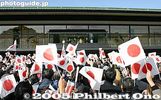
Emperor's Birthday, Dec. 23 at the Imperial Palace398 viewsTokyo
|
|

Musashigawa Stable wrestlers greet visitors397 viewsIncludes Miyabiyama and Musoyama.
|
|

Shinto-style roof. If the house is full, the "Full House" banners are rolled down above the roof. (Now rolled up.)397 views
|
|

Makunouchi dohyo-iri395 views
|
|
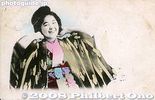
Her affable and infectious smile made her stand out during a time when most people posing for a photograph did not smile.394 views
|
|

393 views
|
|

Ama, another Mongolian and now Yokozuna Harumafuji. The Mongolians are taking over the top echelons of sumo dominated by foreigners. We haven't had a Japanese yokozuna since 2003.391 views
|
|

Woman and cherry blossoms. Unfortunately, she's too hunchbacked in this picture.390 views
|
|

Dancing woman387 views
|
|

Musashimaru merchandise384 views
|
|
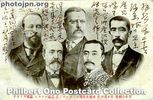
Russo-Japan Peace Conference representatives. Left to right: Russian Finance Minister Count Sergei Witte, Baron Rosen, US President Theodore Roosevelt, Japanese Ambassador to the US Kogoro Takahira, and Japanese Foreign Minister Jutaro Komura.383 viewsIt was a time when nations jostled for territory and trade. The Russo-Japanese War of 1904-05 was waged mainly for the control of Manchuria and Korea. The US fully supported Japan and hoped that Japan would keep Korea open to all nations for commerce. The war started before it was declared with Japan launching a surprise attack to destroy part of the Russian fleet at Port Arthur in Manchuria and landing troops in Korea. The US and Great Britain cheered Japan. The US assumed that Japan would open up Asian markets. President Theodore Roosevelt believed that Japan was fighting Russia for America. But then, he also feared that if Japan won the war, there might be a struggle between the US and Japan in the future.
In the famous Battle of the Sea of Japan on May 27-28, 1905, Japan astonishingly defeated the Russian fleet which had sailed from the Baltic Sea eighteen months before. Even before this battle, Japan was financially drained and asked Roosevelt to mediate an end to the war. Although Japan was winning the war, they were outnumbered by the Russians who had the troops and resources to keep fighting. The Russian czar, however, finally relented after seeing his Baltic fleet destroyed.
A peace conference was held at Portsmouth, New Hampshire in July and Aug. 1905. The principle representatives are pictured in the postcard above. The caption on the bottom of the card identifies these men. The Japanese handwriting in-between is only correspondence and not part of the original postcard which has a postmark dated Aug. 30, 1905.
Harvard-educated Jutaro Komura was a star in Japan's Foreign Ministry and a successful diplomat in Washington DC and Peking. He was in favor of obtaining control in both Manchuria and Korea. Komura also was instrumental in having Japan form an alliance with Great Britain in 1902. This move further strengthened Japan's position vis-a-vis Russia. Anybody attacking Japan would also have to face the British who had the world's largest navy.
Count Sergei Witte created the Trans-Siberian railway and he was highly respected by the US.
For mediating peace between Japan and Russia, President Roosevelt went on to become the first American to win the Nobel Peace Prize in 1906.
|
|

Baruto, from Estonia, at the center. He's well on his way to become Ozeki. There are many foreign sumo wrestlers. Unfortunately, there are none from Hawaii. Mostly Europeans and Mongolians.383 views
|
|

Dai-hiwatari Festival, Mt. Takao382 viewsMore pictures here
|
|

Hakuho collects his pay.382 views
|
|

Entrance hall is clogged up by a side show of hula.381 views
|
|

Calligraphy on a folding fan.380 views
|
|

Wrestlers wait until everyone is on the ring. Notice that Takamisakari (second from the left) and the rikishi on the far right have almost the same aprons. They will serve as the sword bearer and dew sweeper for the yokozuna ring-entering ceremony.379 views
|
|

Giant portrait of Yokozuna Asashoryu377 views
|
|

375 views
|
|

Finish, everybody out please...375 views
|
|

The maiko uses her real hair, not a wig. When her hair is down, it reaches her chest.375 views
|
|

Bride leaving her house vis rickshaw.374 views
|
|

Tidying up the ring372 views
|
|

I'm waiting...371 views
|
|

Kiba Kakunori Square Log Rolling, Tokyo371 viewsHeld in mid-Oct. at Kiba Park, Tokyo.
More pictures here
|
|

Musashimaru at the entrance370 views
|
|

Smiling Maiko sitting in garden369 viewsNotice her left sleeve reaching the ground. A sign of a maiko's kimono, not a geisha's. Also, the high clogs that she wears are called pokkuri. Maiko wear them, but geisha do not.
|
|

Upper level seats.368 views
|
|

New Year's at Taga Taisha Shrine, Shiga366 viewsMore pictures here.
|
|

The striking yokozuna upset makes the crowd go wild as they throw zabuton cushions in glee.365 views
|
|

Break364 viewsAsashoryu took a water break between each practice bout.
|
|

Shaved ice (kakigori) with fruits364 views
|
|

Girl with Bouquet. Would've been a great shot if she had smiled.362 views
|
|
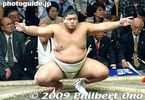
Musoyama (in Sept. 2004).361 views
|
|
|
|